| |
|
 |
 |
|
![Toacana ] Galleria di immagini](../../titels/albump.gif) |
|
| |
 |
|
|
| |
|
The abbey of Monte Oliveto Maggiore |
|
|
|
| |
|
The Abbey of Monte Oliveto Maggiore is located just south of Asciano in the Crete Senesi, near the picturesque village of Chiusure.
The hills around Chiusure characterized here mainly by an eroded landscape, give you a good impression of the Crete Senesi, a region with alternating green meadows, barren hills, and steep, weathered chalk cliffs. These are the so-called calanchi, rock formations composed of limestone, rock salt, and plaster. This sometimes moon-like landscape is also the backdrop for the Abbey of Monte Oliveto Maggiore.
Some beautiful walks in the vicinity of the abbey allow you to explore this region in an ideal way.
|

|
Panorama of the Monte Oliveto Maggiore abbey [2]
|
In the middle of this Crete Senesi, in the most arid part of it, lies the abbey between high, dark cypresses. It was founded in 1313 by some nobles from Siena who were homesick for the simplicity of the Benedictine monastic rule. Only six years later the pope recognized the order of the Olivetans.
Supported by mediators, the abbey became a kind of elite hermitage in central Tuscany.
|

|
The Abbey of Monte Oliveto Maggiore, a large red brick building with a Latin cross plan (1)
|
The Abbey of Monte Oliveto Maggiore
The Abbey of Monte Oliveto Maggiore is a large Benedictine monastery, 10 km south of Asciano. Its buildings, which are mostly of red brick, are conspicuous against the grey clayey and sandy soil — the Crete senesi which give this area of Tuscany its name.
It is a territorial abbey whose abbot functions as the bishop of the land within the abbey's possession, even though he is not consecrated as a bishop.
It is the mother-house of the Olivetans and the monastery later took the name of Monte Oliveto Maggiore ("the greater") to distinguish it from successive foundations at Florence, San Gimignano, Naples and elsewhere.
History
It was founded in 1313 by Bernardo Tolomei, a jurist from a prominent aristocratic family of Siena. In 1319 or 1320 it was approved by Bishop Guido Tarlati as Monte Oliveto, with reference to the Mount of Olives and in honour of Christ’s Passion. The monastery was begun in 1320, the new congregation being approved by Pope Clement VI in 1344.
The abbey was for centuries one of the main land possessors in the Siena region.
On January 18, 1765, the monastery was made the seat of the Territorial Abbacy of Monte Oliveto Maggiore.
Overview
Interior
The monastery is accessed through a drawbridge which leads to a medieval palace in red brickwork, surmounted by a massive quadrangular tower with barbicans and merlons. This edifice was begun in 1393 as the fortified gate of the complex; it was completed in 1526 and restored in the 19th century. Over the entrance arch is a terracotta depicting Madonna with Child and Two Angels attributed to the Della Robbia family, as well as the St Benedict Blessing nearby.
After the entrance structure is a long alley with cypresses, sided by the botanical garden of the old pharmacy (destroyed in 1896) and a cistern from 1533. At the alley's end is the bell tower, in Romanesque-Gothic style, and the apse of the church, which has a Gothic façade.
Chiostro Grande
The Chiostro Grande ("Great Cloister") has a rectangular plan and was realized between 1426 and 1443. On the oldest side it has a two-storey loggia and a pit, dating to 1439. The frescoes of the Life of St. Benedict painted by Luca Signorelli and il Sodoma, located in the cloister lunettes under the vaults, are considered masterworks of the Italian Renaissance.
The frescoes disposition follows St. Gregory's account of Benedict's life. Signorelli's paintings were executed in 1497-98, while Sodoma's were completed after 1505.
The church
|
| |
|
|
|
|
 |
General view on the abbey of Monte Oliveto Maggiore, bell tower and church (2)
|
The church entrance is preceded, in the Chiostro Grande, by frescoes of Jesus Carrying the Cross, Jesus at the Column and St. Benedict Giving the Rule to the Founders of Monte Oliveto, all the work of Sodoma. The church's atrium is on the site of a previous church (1319), showing on the walls frescoes with Father Hermits in the Desert and St Benedict's miracle, both by an unknown Sienese artists. In a niche is the Madonna with Child Enthroned by Fra Giovanni da Verona.
The church takes the form of Latin cross. It was renovated in the Baroque style in 1772 by Giovanni Antinori. The main attraction is the wooden inlaid choir by Giovanni da Verona, executed in 1503-1505. It is one of the most outstanding examples of tarsia in Europe. The church houses also a canvas by Jacopo Ligozzi (Assumption, 1598), behind the high altar, and a 14th-century polychrome wooden Crucifix, in the Sacrament Chapel. The sacristy has an inlaid ceiling dating to 1417.
Chiostro di Mezzo
Che Chiostro di Mezzo ("Middle Cloister") was built in the 15th century, surrounded by a portico with octagonal pilasters. Artworks include a 15th-century Madonna with Child and Angels and Annunciation by Riccio. Nearby is the entrance to the refectory, decorated by frescoes by Fra Paolo Novelli (1670) and, in the end wall, a canvas of the Last Supper by Lino Dinetto (1948).
Library and Pharmacy
The stairs leading to the first floor are decorated by Sodoma's fresco depicting the Coronation of Mary and one by an unknown artist of the I. Antonio Muller (an artist from Danzig) executed in 1631 a Characters and Events of the Olivetani, while by Giovanni da Verona is a wooden candelabrum (1502). The latter artist was also author of the library, which has a basilica plan with a nave and two aisles divided by columns with Corinthian capitals (1518). Nearby is the Monastic Library, housing some 40,000 volumes and incunabula. From the library is the access to the Pharmacy, housing, in 17th century vases, a collection of medicinal herbs.
Definitorio
The name Definitorio refers to the Capitular Hall (1498), on whose end wall is a fresco of Madonna with Child and Saints by Matteo Ripanda (16th century); the hall houses a small museum of Sacred Arts, with works by Segna di Bonaventura (Madonna with Child), the Master of Monte Oliveto (Maestà), Neroccio di Bartolomeo (St. Bernardino), Vincenzo Tamagni (Madonna with Child) and a fresco portraying St. Sebastian by an artist of the Sienese School.
|
|
|
|
| |
|
|
|
| |
|
Chiusure is a small village near the Abbey of Oliveto Maggiore. There is hardly anytthing to see, but the simplicity of the houses, the picturesque alleys and paths that run behind the houses, give you a good picture of everyday life in a Tuscan village. Enjoy la dolce vita on the terrace of Locanda Paradiso.
The view is very beautiful here. The hills extend from the Val d'Orcia to Monte Amiata and the Colline Metallifere. The silhouette of Siena is also clearly visible in clear weather.
|
 |
|
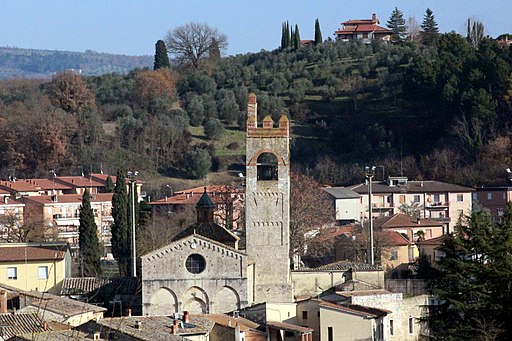 |
|
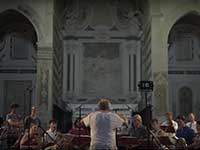 |
Chiusure and the Campanile of Santa Maria di Monte Oliveto Maggiore
|
|
Asciano
|
|
Philippe Herreweghe repeteert in de Chiesa di San Francesco
|
The annual Sagra del carciofo, the 'artichoke festival', which takes place in April, is a special event. For four days you can enjoy local products and a musical program. Consult Asciano's comune for precise information (data, program etc.).
And there is more music to experience.
Het zomerfesivali lokt elke zomer overwegend Vlaamse muziekliefhebbers naar de Crete Senesi.
Het Festival Accademia delle Crete Senesi zoals het festival vroeger werd genoemd, werd opgericht door Philippe Herreweghe die in de buurt van Chiusure woont. Het programma is verfijnd en van een internationaal niveau. Concerten in de Crete Senesi vinden plaats in het Monasterio Sant’Anna in Camprena bij Pienza, de Chiesa Santo Stefano in Castelmuzio en in de Chiesa San Francesco in Asciano.
Zonder meer het beste muziekfestival van Toscane.
The summer musicfestival Collegium Vocale Crete Senes attracts Flemish music lovers to the Crete Senesi every summer. The festival Accademia delle Crete Senesi as the festival was formerly called, was founded by Philippe Herreweghe who lives in the neighborhood of Chiusure. The program is refined and of an international level. Concerts in the Crete Senesi take place in the Monasterio Sant'Anna in Camprena at Pienza, the Chiesa Santo Stefano in Castelmuzio and in the Chiesa San Francesco in Asciano.
Without doubt the best music festival in Tuscany.
Music festival Collegium Vocale Crete Senesi | Program
Itineraries in the Crete Senesi
In the surroundings of Chiusure, some nice walks were drawn up by the Tuscany region. The walks are well marked according to Italian standards. The landscape is impressive. You will find a map with the most beautiful walks in the area of Monte Oliveto Maggiore here.
|
 |
|
 |
|
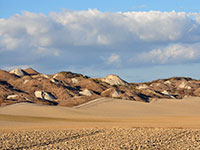 |
Anello Chiusure - Abbazia Monte Oliveto Maggiore
|
|
Walk in the magical setting of the Crete Senesi, along the lakes of Santa Caterina and Menchiari
|
|
Circel walk along the Biancane Leonina
|
From San Giovanni d'Asso to Monte Oliveto Maggiore | 10.46 km| 2h
This walk will take you to one of the most beautiful valleys in the Crete Senesi in southern Tuscany. A well-marked road leads to Chiusure and the Monte Oliveto Maggiore Abbey. You walk along strade bianche, the idyllic paved roads of the Crete Senesi, through hills with silver olive groves, small villages and vineyards. The visit to the Abbey of Monte Oliveto Maggiore with the frescoes of Luca Signorelli and Il Sodoma, the old wine cellars and the magnificent library, is the cultural highlight of this itinerary.
From Monte Oliveto Maggiore to San Giovanni d'Asso | 6,48 km | 1,5 hours
Anello Chiusure - Monte Oliveto Maggiore, Asciano | 5,64 km | gpx
Buonconvento - Abbazia Monte Oliveto Maggiore | 11.60 km
From Montalcino to Buonconvento to Monte Oliveto Maggiore | 16 km | 3 hours circa

Podere Santa Pia is a rural former monastery farm from the 19th century. With a sweeping view from 300 meters above sea level, Podere Santa Pia sits on a hill dominating the valleys of the Ombrone and Orcia rivers, in the heart of the Tuscan Maremma, 30 km south of Montalcino. The view is unique and breathtakingly beautiful.
This fabulous domain is now divided into two units, a spacious house that can accommodate 11 people, and a spacious apartment. The original cotto tiles on the floor, the wooden beams on the ceiling and the simple but tasteful decor exude the homely atmosphere of a Tuscan country house. The simple interior and the minimalist interventions perfectly match the simplicity of the Tuscan country houses of yesteryear. A nice selection of contemporary graphics by artists such as Jürgen Partenheimer, Ronald Noorman, Philippe Vandenberg and Hanns Shimansky make this place a high-quality holiday home.
The pizza oven and large caminetto in the authentic kitchen guarantee culinary delight.
The biggest asset of this holiday home is its location with a stunning view. It seems like the whole southern Tuscany is here at your feet, where your eyes keep losing. Several terraces offer space to dine al fresco with a breathtaking view over the valley and multicolored sunsets.
Holiday houses in Tuscany |Podere Santa Pia
|
|
|
|
|
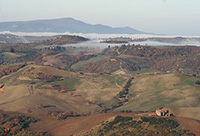 |
| |
|
|
|
Breathtaking view from Podere Santa Pia on the Ombrone valley and ColleMassari |

|
|
|
| |
|
|
|
|
| |
|
|
|
|
Album Chiostro grande del monastero di Monte Oliveto Maggiore
|
 |
|
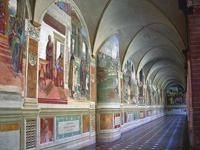 |
|
 |
Album Monastero di Monte Oliveto Maggiore
|
|
|
|
|

|
|
|
 |
|
 |
|
 |
Crete Senesi presso Asciano
|
|
Deserto di Accona |
|
Biancane nelle Crete Senesi vicino a Monte Oliveto Maggiore
|
Restaurants in Chiusure
Enjoy lunch at Locanda Paradiso at Chiusure (Via Porta Senese 25) or Ristorante La Torre at Monte Oliveto Maggiore.
Chiusure
Locanda Paradiso
Locanda Paradiso
Via Porta Senese 25, 53041 Chiusure, Asciano
+39 0577707117
Website Facebook: /www.facebook.com/Locanda-Il-Paradiso
Ristorante La Torre
Ristorante La Torre
Localita' Monteoliveto Maggiore, 2, 53041 Asciano
+39 0577 707022

Collegium Vocale Crete Senesi | www.collegiumvocalecretesenesi.com
Contact:
Via Moglio 15, I 53024 Montalcino (Si)
Tel & fax +39 0577 84 52 32
info@accademiadellecrete.com
|
Podere Santa Pia is an artistic property, perfect for relaxing and enjoying the splendor of the Maremma hills of southern Tuscany. This formerl cloister offers the quiet tranquility of a private retreat, with numerous attractions, beautiful nature reserves and unspoilt beautiful beaches within easy reach.
|

[1] Photo by peuplier, licensed under the 2.0 Generic license.
[2] Photo by Acer11, licensed under the Creative Commons Attribution-Share Alike 3.0 Unported, 2.5 Generic, 2.0 Generic and 1.0 Generic license.
|
|
|
| |
|
|
|
| |
|
|
|
| |
|
|
|
| |
|
|
|
| |
|
|
|
| |
|
|
|
|